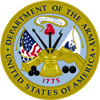The Pentagon is centrally located and is close to multiple military bases and facilities. The building is in Virginia along the Potomac River situated right across from Washington D.C. and is the headquarters for the Department of Defense (DoD).
Construction began in the fall of 1941 and the building was officially dedicated in 1943. Nearby bases include Joint Base Anacostia-Bolling, a 20 minute drive from the Pentagon, Fort McNair, just 10 minutes away and Joint Base Andrews (in Maryland), a mere 30 minutes away. Additionally, the Marine Barracks are less than 20 minutes away from the Pentagon.
Quick Facts
| Coordinates | 38° 52' 15.56" N 77° 03' 21.46" W |
|---|---|
| City | Washington, DC 20301 |
| Phone | 703-545-6700 |
| DSN | — |
Dimensions
- The Pentagon has 5 sides (penta-, derived from the Greek, is a prefix meaning 5) and 5 floors above ground and two floors at basement level.
- The building spans 6,500,000 square feet and features a five acre plaza commonly referred to as Ground Zero.
- The Pentagon stands at 77 feet tall and each of the five sides is 921 feet long.
- The Pentagon features 17.5 miles of hallways and a total floor area of just over 6.5 million square feet.
General Information / Facts
Address: The Pentagon Washington, DC 22202 Phone: (703) 697-1776
- Due to a shortage of steel at the time and a desire to preserve the scenic views of the Potomac and Washington, the Pentagon was kept to 5 stories tall.
- The Pentagon was built mostly using concrete; most of the filler to make the concrete was taken from the Potomac River.
- Major Leslie Groves, an officer in the U.S. Army Corps of Engineers (and subordinate of Brigadier General Brehon B. Somervell--the lead on the Pentagon project) oversaw the construction of the building and was also head of the Manhattan Project, a successful U.S. effort to create the world's first atomic bomb.
- Due to segregation and the time during which the Pentagon was built, the building has twice as many bathrooms as necessary.
History
When President Roosevelt declared a state of national emergency in May of 1941, it became imperative to find a locale that could accommodate thousands of federal employees as the world fought against the rise of Nazi Germany. Brigadier General Brehon B. Somervell proposed building headquarters for the War Department that would house 40,000 employees and be situated on land that was once part Confederate General Robert E. Lee's estate.
Ground was broken on September 11, 1941 and the Pentagon was complete and opened on January 14, 1943. A pentagon was chosen as the shape for the building due to the roads that were in the immediate vicinity of where the Pentagon would be erected.
Initially, there were protests about the building site--many people were upset that the proposed location for the Pentagon would be so close to Arlington National Cemetery; because of this, President Roosevelt decided to move construction to an area next to Washington-Hoover Airport. With this new location, it wasn't necessary to utilize the pentagon shape for construction, but the original plans were kept due to time constraints.
Even before the Pentagon was completed, it was packed with people. In fact, three months after construction began, there were 3,000 laborers working towards finishing the building. When the Japanese attacked Pearl Harbor in December 1941, construction efforts doubled down; in March of 1942, just a few months after the attack, there were 10,000 people working at the Pentagon. During peak construction, there were 15,000 people working 24 hours a day spread across three shifts to complete the building.
The Pentagon welcomed its very first employees in the spring of 1942 before officially opening less than a year later. The original budget was set at $35 million but would end up costing $75 million in total.
After World War II, people began petitioning for the Pentagon to be turned into a various facilities--a hospital, a veteran's center and a university were all proposed but the Army decided against all of these. Under the direction of James V. Forrestal, the first Secretary of Defense, the Pentagon became the headquarters for the Navy, Army and Air Force. Sadly, the stress of this responsibility along with an existing mental illness would drive Forrestal to have a nervous breakdown and later commit suicide.
Tragedy Strikes
Even with all of the security measures protecting the Pentagon and its occupants, the building has experienced violence and terrorism on more than one occasion. In May 1972, someone who was part of an antiwar group left a bomb in a women's bathroom that was detonated just past midnight--thankfully, no one was injured but extensive damage occurred totaling $75,000.
On September 11, 2001--the Pentagon's 60th anniversary--a hijacked plane crashed into the building shortly after the Twin Towers in New York City were hit, resulting in a 36-hour long fire and the deaths of 189 people. A memorial in honor of the victims was unveiled on the 7th anniversary of the attack.
Surrounding Area
There are tons of things to do and see near the Pentagon ranging from museums and memorials to shopping and walking, biking and even Segway tours.
The Pentagon Memorial is a must see--a bench for every victim of the 9/11 attack was erected to honor the fallen. There are multiple memorials you can visit including: the Air Force Memorial, Martin Luther King Jr. Memorial, Lincoln Memorial and the FDR Memorial.
You can visit the Tomb of the Unknowns as well as the beautiful National World War II Memorial. John F. Kennedy's grave is also nearby as is the Washington Monument and the National Mall.
Hotels
There are lodging options all within a few minutes to a few miles distance from the Pentagon. They include:
- The Westin Crystal City, (703) 486-1111.
- DoubleTree by Hilton Hotel Washington D.C. - Crystal City, (703) 416-4100.
- Holiday Inn National Airport/Crystal City, (703) 684-7200.

